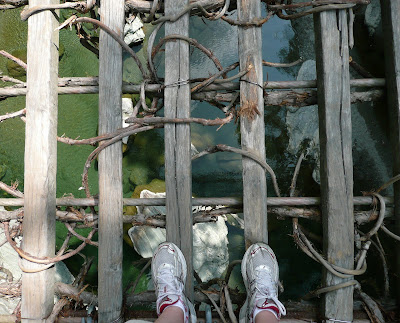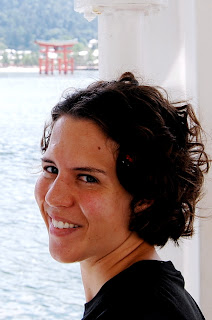 On Day 2 of our great Shikoku adventure, Joe and I rose bright and early to devour a hearty breakfast of salad, omelets and goats milk in Ueda-san's kitchen with the six French girls. Then she drove us back to the train station and bid us farewell before we boarded a bus for an hour ride to the Iyano Kasurabashi (Iya Vine Bridge).
On Day 2 of our great Shikoku adventure, Joe and I rose bright and early to devour a hearty breakfast of salad, omelets and goats milk in Ueda-san's kitchen with the six French girls. Then she drove us back to the train station and bid us farewell before we boarded a bus for an hour ride to the Iyano Kasurabashi (Iya Vine Bridge).Japan designates this bridge as "An Important National Tangible Cultural Asset." In ancient times, local people used vines growing wild in the mountains to build bridges across the river for daily travel. Only three of these bridges remain today and this particular bridge over the Iya River is the largest and most famous. It is 5 feet wide and almost 50 yards long — not quite the perilous Indiana Jones-style bridge from my imagination, but impressive nonetheless.

There are several legends about when and why this bridge was built. According to one of these legends, the bridge was built during civil war in 1185. The clan that built the bridge made it out of vine so the bridge could be easily cut in the event of a pursuit.
500 yen ($5) buys you the privilege of crossing the bridge. This would indeed be a feat for those with the fearlessness of Indiana Jones — if this bridge were actually the one originally built in 1185. Alas, it is not. The bridge itself has been reinforced with steel cables. Every three years, the vines are replaced and the bridge is built anew. The sign at the entrance to the bridge says this is to preserve the bridge and ensure that the skills of working with natural vine and building such structures are passed on to future generations. And of course to make sure that tourists paying five bucks don't cripple themselves with a fall to the jagged rocks below. Might be bad for business.

Still, crossing the bridge isn't for the faint of heart. The planks are set far enough apart that your entire leg could very easily fall through if you aren't careful. And the thing does bounce and wobble a good bit while other people are walking on it. Especially people Joe's size.



Once safely on the other side, Joe's repressed survival instincts came rushing back and he went on the hunt to fill his growling stomach. Luckily this little old Japanese lady was conveniently selling fish on a stick by the side of the road.


Like a savage, Joe devours the very dead-looking fish!
Next it was on to a nearby waterfall, which was very pretty.

Then we waded around in the river for a while and picked up cool-looking rocks. Once we were properly cooled off we struck out in search of a fertility shrine that Joe thought was nearby. All we found was a mysterious fenced-off cave with a weird statue and a ticket window that was closed. Aside from some cool multi-colored lizards we saw darting across the road on the way, that was a fruitless excursion.


At this point, looking at the maps and sweating and realizing how far away various points of interest were, we realized we weren't going to see much else without a car. That was a bit disappointing, but we did find a nice campground, so maybe if one of us decides to get a Japanese driver's license we can come back someday and camp and see a bit more of the area.
We walked back to the bridge and took a bus recommended by Ueda-san for its scenic route back to the train station. Little did we know that this would probably be the scariest bus ride of our life. We were the only ones on the bus. Peering out the windows as the bus barrelled around the mountain terrain on a winding one-lane road, our mouths hung at the sight of the tiny guard rail separating us from a precipitous drops down the side of a mountain. Twice, cars zipping around curves in the road came head to head with the bus and had to jam their brakes and back up until they hit a spot where the bus could creep by.
Luckily, the breathtaking views of the deep river canyon kept our eyes off the road most of the time.



At one point, we caught a fleeting glance of the famous peeing boy statue situated near the top of one of these slopes, but it went by too fast to take a photo, unfortunately.
Back at the train station, we boarded the train to Tokushima, an hour and a half ride away.
Tokushima struck me as a pleasant and clean city. The area around the train station was quite built up with shops and restaurants. We got busy hunting down the tourist information desk to gather brochures, find bus and train schedules and make arrangements to stay at the Tokushima Youth Hostel. The hostel turned out to be located on a beach in a park a half-hour bus ride away, with the last bus leaving early in the evening. So we didn't go exploring that evening as we had to make it to the hostel.
This place turned out to be quite a disappointment to us. It was located in what looked to be a run-down old school building. They charged us 3500 yen ($35) a piece to stay in a room with four bunk beds (though we didn't have to share with anyone else). The (rather shoddy) air conditioner in the room came at a cost as well. You had to feed it 100 yen ($1) for every two hours of a/c. And of course we had the bus fare to get us to this place and back downtown, a 600 yen ($6) round trip cost per person. The rooms were dingy and the bathrooms were thoroughly disgusting. I had to stop breathing through my nose in there to keep from tripping my gag reflex. And the beach turned out to be a disappointment as well with lots of rocks and trash. To top the whole thing off, I discovered before bed that I'd forgotten my glasses back at Ueda-san's guest house. And we realized after looking through our new brochures that we could have taken an actual tour bus through the Iya Valley that would have stopped at the sights we couldn't reach on foot (including the peeing boy statue), leaving from the same station we'd been at. But we had not seen any mention of the tour bus while we were actually at the station. Needless to say, I was not a happy camper at bed time. At least the bunk beds in the hostel were reasonably comfortable, though.
But, things started to look up the next morning on Day 3 of our journey once we got the heck outta there and hopped on the bus yet again to see another wonder of nature: the Naruto whirlpools.
Tokushima struck me as a pleasant and clean city. The area around the train station was quite built up with shops and restaurants. We got busy hunting down the tourist information desk to gather brochures, find bus and train schedules and make arrangements to stay at the Tokushima Youth Hostel. The hostel turned out to be located on a beach in a park a half-hour bus ride away, with the last bus leaving early in the evening. So we didn't go exploring that evening as we had to make it to the hostel.
This place turned out to be quite a disappointment to us. It was located in what looked to be a run-down old school building. They charged us 3500 yen ($35) a piece to stay in a room with four bunk beds (though we didn't have to share with anyone else). The (rather shoddy) air conditioner in the room came at a cost as well. You had to feed it 100 yen ($1) for every two hours of a/c. And of course we had the bus fare to get us to this place and back downtown, a 600 yen ($6) round trip cost per person. The rooms were dingy and the bathrooms were thoroughly disgusting. I had to stop breathing through my nose in there to keep from tripping my gag reflex. And the beach turned out to be a disappointment as well with lots of rocks and trash. To top the whole thing off, I discovered before bed that I'd forgotten my glasses back at Ueda-san's guest house. And we realized after looking through our new brochures that we could have taken an actual tour bus through the Iya Valley that would have stopped at the sights we couldn't reach on foot (including the peeing boy statue), leaving from the same station we'd been at. But we had not seen any mention of the tour bus while we were actually at the station. Needless to say, I was not a happy camper at bed time. At least the bunk beds in the hostel were reasonably comfortable, though.
But, things started to look up the next morning on Day 3 of our journey once we got the heck outta there and hopped on the bus yet again to see another wonder of nature: the Naruto whirlpools.
